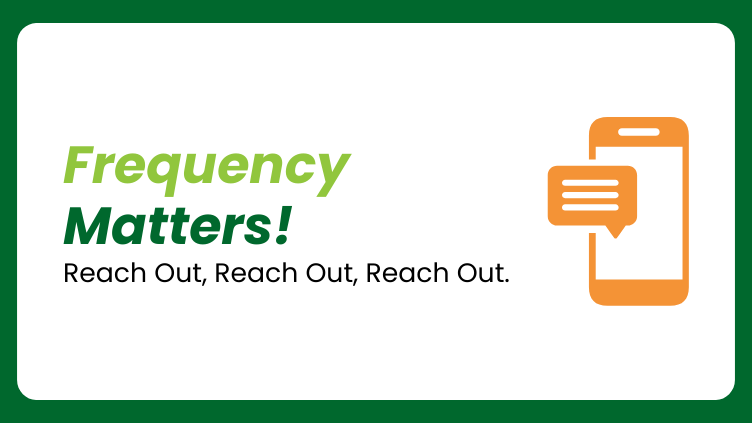
Reach Out, Reach Out, Reach Out (Frequency Matters!)
Sting’s messaging strategy had it all wrong. He sent a message in a bottle, and loneliness ensued, and a broken heart. He only had hope to keep him together, to rescue him from despair. Now, eventually, a hundred billion bottles did wash up on the shore, and he found out he wasn’t alone at being alone. But he had to wait a whole year. Not too effective for immediately engaging with his audience.
But we have the internet. And social media. On which everyone loves to communicate.
One of the components for being effective is to define and execute your frequency of messaging model. We need to set goals and then flip the switch, turn on the spigot, and reach out. (For motivation with the team/dept., you might measure and award them for connections and/or messaging.)
First, think about the content with which you’re going to be frequent. Let’s review what we talked about in previous blog posts:
Know what questions your target is asking
Be consistent – it’s a 20 mile march
Know your audience, pick the best time(s)
And, don’t use Corporate Speak – be authentic to your voice
If being consistent on your “march” is the highway, then frequency is your speed limit. Frequency can be tricky. You don’t want to be a noodge over-poster; you’ll quickly be dismissed and overlooked as annoying. But you also don’t want to be too sparse and infrequent; your message audience might end up being only crickets.
Again, we also have to think about the content channels, your message, and your core audience. There are studies about appropriate frequencies on these highways. Some are super-highways, and some are rambling 2-lane country roads. If Twitter is part of your media vehicle mix, then some studies have shown that engagement starts to drop off after the 3rd Tweet. But, Buffer shows that if you want to maximize the most value from Tweeting as a whole, on your macro Brand presence, you can Tweet up to 30 times a day. That’s a lot of thumb work. Really, about 5 x’s/day is optimal (a Tweet gets “old” after 18 minutes). So Twitter would be the express lane on the super-highway, or the Autobahn if you go for 30/day.
Note: your frequency plan will of course vary if you have to factor in all 4 times zones and any international audiences. Buffer actually recommends Tweeting 14 times per day including early a.m. US Eastern times to reach the international audience.
Facebook and Instagram are probably a solid Interstate highway. I-75 traveling North. Or I-80 going West. Recommended optimal posting is generally no more than 2 per day, maybe 3 on Instagram.
So that leaves LinkedIn for looking at the major thoroughfares. LinkedIn says that optimal is really 1 time per weekday, 20 times per month. So, LinkedIn is more like a major U.S. Route highway, with long stretches to go pretty fast, mixed with traveling through towns where you might hit a few stop lights. Overall your average speed is a little slower, requiring a little more attention and thought. Make the 1 post really count for engagement, but that’s not to say you can’t post other content at other times to perhaps bolster your awareness“presence”.
So just like the shampoo bottle says: lather, rinse, repeat. Plan out your frequency model and then be frequent. Don’t be a stranger.
* * *
Floodgate Medical is proud to have been ranked #9 in LinkedIn’s 2017 Top 25 Most Socially Engaged Staffing Agencies for North America in our category.




